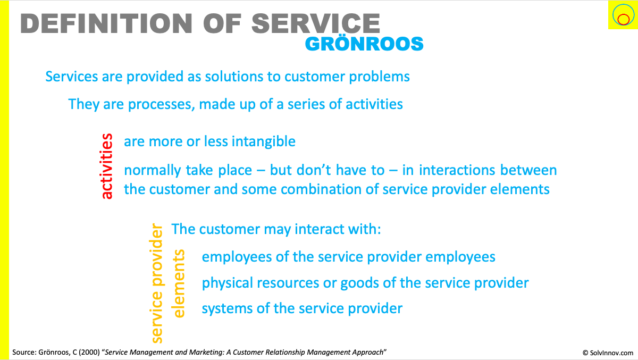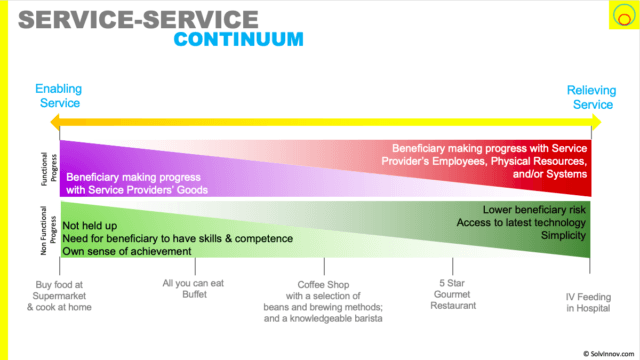The Big Picture…
The service mix helps us avoid myopia in innovation and gives us the framework to see what components we can mix between in our efforts to help beneficiaries make progress.
It is found in our definition of service. Which, rather than seeing the traditional division between goods and service sees goods as a distribution mechanism for service. And they are one of four elements that may be interacted with in the act of service.

These four elements – employees, physical resources, goods and systems – I call the service mix. And we find it also as part of my updated Service Marketing Triangle.
Implications
Altering the service mix is a source of innovation.
And seeing there exists a mix helps enterprises be less short-sighted (myopic) in their view of innovation.
It is also reflected in the service-service continuum. This helps us explore the beneficiaries view of value as we alter the mix.
The Idea
We build our typical definition of service through comparing them to a belief that goods and simple to define. They are inconsistent, intangible, inseparable, require involvement and we can’t create an inventory (we know this is limiting and incorrectly negative).
But service-dominant logic and a better view of value lead us to a service forward definition of goods and service. And it is one where we find goods are a distribution mechanism of service. In fact, they are just one of the four components a beneficiary may interact with from the eco-system in an act of service. Along with employees, physical resources, and systems.
These four components are the service mix.
And we can innovate by altering this mix for any particular service. Additionally, we can observe there is a service-service continuum helping us understand how and why beneficiaries make functional and non-functional progress. Self-service using goods, for example, might be preferable due to the non-functional progress of sense of achievement. But comes with a greater need for the beneficiary to have skills and competence. Which might increase innovation resistance.
What is a Service?
I dig, in detail, into what service is in this set of articles. From which I prefer the definition given by Grönroos, shown in Figure 1.
Although I usually update it a little to reflect my view of value being based around progress a beneficiary (for example a customer) is seeking to make. You can see those changes in Figure 2.
And it is within these definitions we find what I call the service mix.
What is the service mix
You’ll find the service mix sitting at the end of our definition of service – see Figure 2. And it shows that customers (beneficiaries) may interact with 4 different types of elements in the act of service:
- Employees
- Physical resources or goods
- Systems
The ecosystem that is making the value proposition decides and provides those elements.
Now, you might find treating goods as a distribution mechanism for service a bit odd at first glance. And it comes about due to the lens I’m choosing to look through – that of service-dominant logic.
Think of it this way. When you’re thirsty, you could take a glass of water from the tap, or pull a bottle out of the fridge. And we usually think of the former as a service, the other a goods. But in service-dominant logic, we choose to see both as a service. It’s just in the bottle, the service has been frozen at source so it can be physically transported. And when you open the bottle, you unfreeze the service.
Observing there is a service mix is important for two reasons. Its a source of innovation. And it helps reduce myopia.
Source of Innovation
Altering how much provision of each element for any particular service is a source of innovation. You can see this as a toy example in Figure 3. Where we are planning on reducing the focus on goods in the current service mix to one where employees and physical resources play a bigger part. And where systems are much more important.
Whilst Figure 3 doesn’t reflect any real-life example, you could see it as an example of servitisation. Such as Rolls Royce moving from selling aircraft engines (traditional view of goods) to selling power by the hour (traditional view of a service). In such a case, goods are almost removed – becoming physical resources instead. And digital twin, monitoring and logistical systems become key in providing the service.
Reduces Myopia
Observing there is a service mix is a key tool in avoiding short-sightedness in innovation. Levitt defined this short-sightedness as marketing myopia. If we only think in terms of what we offer today, we risk only trying to improve the same thing. We can see this as the “adding another razor blade” syndrome. In reality:
People don’t want a quarter-inch drill, they want a quarter-inch hole
Gallo, A (2016) A refresher on Marketing Myopia
The service mix encourages us to think about how that quarter-inch hole can be created beyond just providing a better quarter-inch drill.
Service-service continuum
My service-service continuum helps us understand how beneficiaries are making their progress with a service mix and why.
It can be used to explore where we might make changes to the service mix and what the implications are.
For example, moving more towards self-service via goods implies a greater need for the beneficiary to have skills and competence to use the goods. This may lead to innovation resistance. But they may value a sense of achievement higher.
Or, moving away from goods lowers beneficiaries’ risks. But they may be held-up (have to wait). So if that is important, then how can the systems part of the mix be increased to make it more 24/7.
Wrapping Up
This tool – the service mix – helps us avoid myopia in innovation and gives us the framework to see what components we can mix between in our efforts to help beneficiaries make progress.
We find the service mix also sitting in the updated service marketing triangle.



